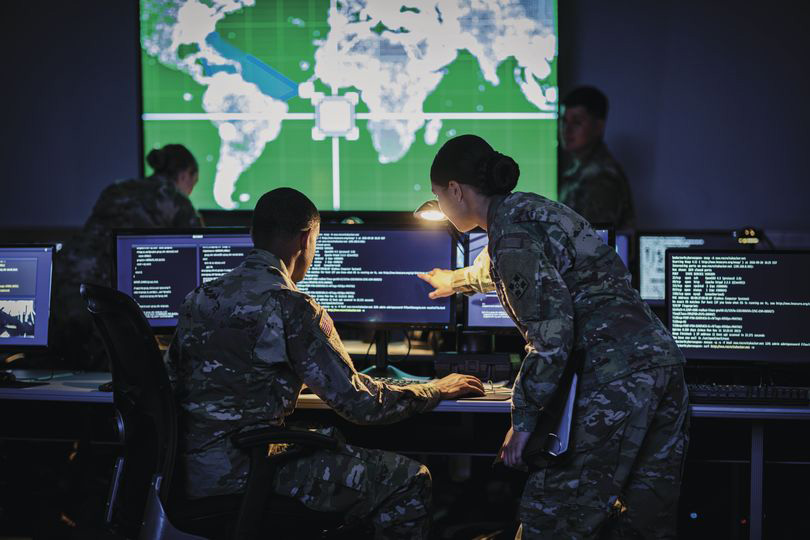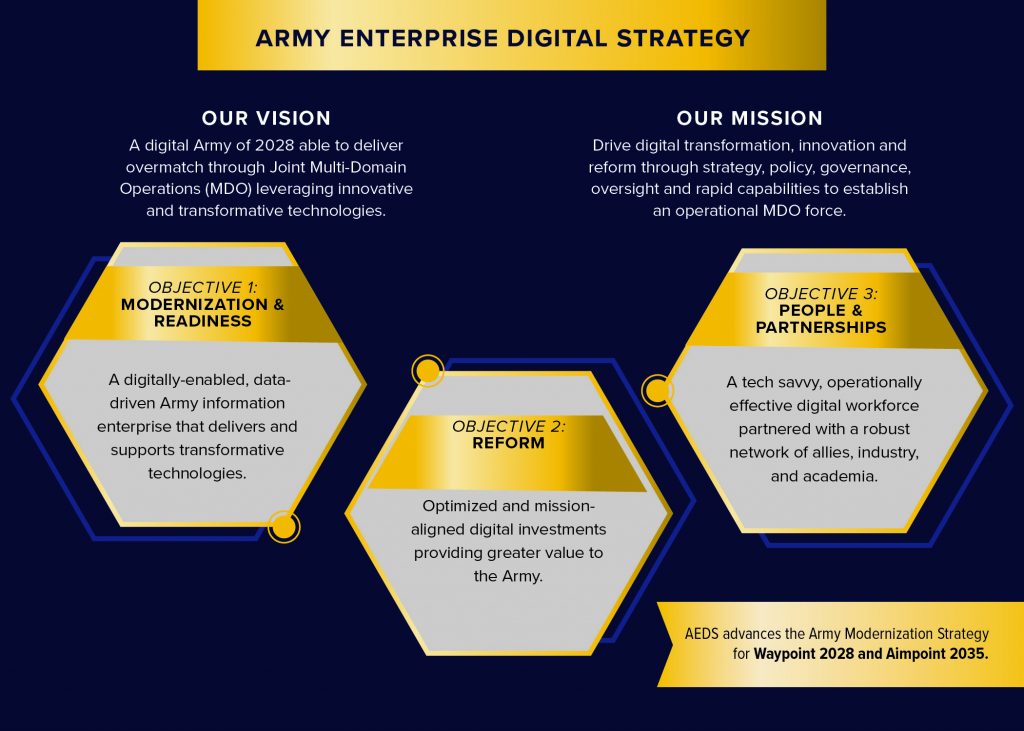
IN OUT SIGHTS: “The Army must be manned, trained, equipped, and modernized to be ready to fight today, but also to meet the demands of an uncertain and unpredictable future,” says Secretary of the Army Christine Wormuth. (U.S. Army photo)
The Army’s Office of the Chief Information Officer sets the strategic direction toward a lethal, ready and digital Army of 2028.
by Dr. Raj Iyer
The Army’s modernization strategy identified digital transformation as key to achieving its goal of a lethal and modern force by 2028. Keeping pace with rapid changes in technology has been historically challenging for the Army as a result of inflexible institutional processes, legacy policies that have not kept up with new technologies, such as cloud and artificial intelligence (AI), and a workforce that is not empowered to innovate at scale.
To better position the Army, the Office of the Chief Information Officer (CIO) is tasked with driving a comprehensive digital transformation strategy: a new approach that boldly invests in transformative digital technologies, reforms institutional processes and builds a workforce equipped to operate in increasingly complex environments.
Digital transformation in the Army requires a holistic doctrine, organization, training, materiel, leadership, personnel and facilities approach that enables new digital technologies such as cloud, data and AI to fundamentally transform processes. This will enable a culture change in the Army to one that is agile, innovative and tech savvy. As the Army’s modernization strategy states, such an approach is critical to the U.S.Army maintaining digital overmatch against our strategic competitor adversaries both in competition and conflict.
GET TO KNOW THE OFFICE OF THE CIO
To achieve digital transformation at scale across the Army required the Army to establish a new organization with a focus on developing and fielding forward-leaning technologies across the enterprise, to establish new policies consistent with digital technologies; and to establish the framework for the digital workforce of the future—all of this to be accomplished in a fiscally constrained future. On Aug. 31, 2020, the Army separated the Office of the CIO from the Army deputy chief of staff, G-6 (DCS G-6), to serve as a new principal official in the secretariat.
The CIO serves as the principal adviser to the secretary of the Army, setting the Army’s strategic direction, policy and oversight for information technology, cloud, cybersecurity and data. The DCS G-6 is the senior military adviser to the chief of staff of the Army and the CIO on policy planning and implementation, with specific responsibilities to set the unified network for multidomain operations.

IN CONTROL: The Army must instantly share data and information to the warfighter and commands in direct support of Army readiness and modernization. (U.S. Army photo)
EARLY ACCOMPLISHMENTS
The Office of the CIO established a few foundational changes very early on to kick-start digital transformation in the Army. The first was to establish a new governance structure to enable synchronization, prioritization and integration of the various digital efforts underway. The Army Digital Oversight Council, chaired by the CIO, is the first such across DOD to integrate efforts across mission areas and to serve as the integrator for the planning, programming, budgeting and execution process to ensure the Army’s $15 billion annual information technology and cyber budget align with Army priorities.
In January 2021, the Office of the CIO elevated its Enterprise Cloud Management Office to the status of field operating agency and renamed it the Enterprise Cloud Management Agency, granting the Office of the CIO greater autonomy and flexibility. This agency is committed to the adoption of new cloud and digital technologies across the enterprise. Since its inception, the agency has established the Army’s first accredited development, security and operations platform called CReATE (the Coding Repository and Transformation Environment) in support of the Army Software Factory, established both unclassified and classified cloud environments in commercial cloud service providers called cArmy, and established a centralized contract for discounted procurement of cloud services. The agency also supported the migration of several mission-critical applications to the cArmy cloud resulting in early cost savings for the Army.
The Office of the CIO also provided oversight to the Army’s implementation of the cloud-based Army-365 collaboration platform across 1 million users worldwide—considered the largest Microsoft 365 implementation ever only next to Walmart.
These recent accomplishments are a great source of pride, but ultimate success will come from the Army’s ability to achieve a digital Army of 2028. In that light, the Office of the CIO developed an integrated, collaborative and holistic approach to guide future efforts—the Army enterprise digital strategy.

GUIDING THE WAY: The Army Enterprise Digital Strategy seeks to invest in transformative digital technologies, reform digital investments and build a tech-savvy workforce equipped to operate in increasingly complex environments. (Graphic by the Office of the CIO)
THE ARMY ENTERPRISE DIGITAL STRATEGY
The Office of the CIO’s Army enterprise digital strategy will lead the Army through changes in technology, processes and overall culture. The strategy establishes the vision for how digital transformation can help achieve the Waypoint 2028, the Army’s construct for victory in multidomain operations. The strategy indicates clear lines of effort leading to this objective, identifies priorities for the Army to resource, and outlines an integrated master plan to synchronize and better integrate all ongoing activities to achieve the digital-age Army.
The strategy outlines lines of effort to support each of the objectives relating to modernization and readiness, reform and people and partnerships.
OBJECTIVE 1: A digitally-enabled, data-driven Army propelled by digital transformation.
The Army’s current digital initiatives are siloed across mission areas, inhibiting the interoperability needed to support multidomain operations. In addition, the Army continually struggles with prioritizing resources for modernization over current year operational readiness. This has led to costly maintenance of legacy systems that are not sustainable and perpetuate silos while simultaneously investing in priority modernization efforts like cloud computing. Similarly, the Army has struggled to balance resourcing information technology (IT) service delivery and cybersecurity across the enterprise while also prioritizing modernization of the unified network.
Between 2021 and 2028, our goal is to converge current digital initiatives that support readiness and modernization into a single integrated plan, enable these initiatives at the enterprise level so they are available to the total Army from the tactical edge to the enterprise core, and establish standardized service delivery processes, methods and tools, all fully leveraging cloud as an enabler. We will develop an Army that seamlessly shares data and information for timely insights to warfighter, commands and enterprise functions, in direct support of Army readiness and modernization.
OBJECTIVE 2: Optimized and mission-aligned digital investments providing greater value to the Army.
Operational excellence is an imperative for the Army in light of the tight fiscal reality. With the evolution of technology, commercial organizations are finding lower cost, more efficient and innovative ways to run and invest in their enterprises. The Army seeks to maintain pace with the evolving advancement of technologies, but this requires a reevaluation of priorities, resourcing and investments.
Current challenges include limited visibility into our IT portfolios, inflexible and waterfall IT acquisition processes, and ineffective IT investment accountability and oversight. These challenges prevent us from ensuring our resources and spending is best aligned to save costs, improve operations, and ultimately harvest these savings to modernize the Army through digital transformation.
Our goal is to optimize the Army’s resources and enable confident investment decisions that are data-driven and objective while at the same time ensuring direct alignment of these investments to Army priorities. With improved and more efficient institutional processes for acquisition, budget and portfolio management, the Army can ensure better alignment of digital resources to current and future digital requirements.
OBJECTIVE 3: A tech savvy, operationally effective digital workforce partnered with a robust network of allies, industry and academia.
People drive success. Our people and our relationships with allied partners are vital to achieving our goal to dominate in multidomain operations. In today’s digital transformation revolution, simply having the newest technology is not sufficient—we need the right digital skills to optimize and fully apply the technology through innovation. Similarly, simply having strong partner relationships is not enough—the Army needs proper channels, networks and systems in place to effectively collaborate and communicate. The Army faces internal challenges with ensuring its workforce can understand, develop, apply and enable digital priorities as well as external opportunities to improve collaboration with allies, academia and industry. Our goal is to embrace the recognition that people drive Army’s success on and off the battlefield. Robust recruiting, training programs, digital career models and partnerships with academia and industry will build a digital ready, adaptive and innovative workforce. In addition, sustained communications and interoperability with allied nations will ensure we optimize our ability to collaborate in all domains.
The Office of the CIO has established 13 priority lines of effort to support the three objectives listed above. These priorities will drive resourcing decisions in future in austere fiscal conditions, while at the same time achieving unity of effort across the Army. The Office of the CIO is working closely with the DOD CIO, joint staff, the Defense Information Systems Agency and other military department CIOs to better integrate and leverage lessons learned from each agency, while also staying fully aligned with the DOD CIO’s digital modernization strategy. Priority initiatives in the strategy will be monitored through the oversight council to ensure they meet mission outcomes. At the same time, the Office of the CIO is reviewing and updating current policies to ensure they are not an impediment to innovation and fully support digital transformation.
SAY HELLO TO THE ARMY OF THE FUTURE
The Office of the CIO is setting the stage for digital transformation and collaboration across the Army enterprise and around the world. The Hon. Christine Wormuth, secretary of the Army, said, “The Army must be manned, trained, equipped, and modernized to be ready to fight today, but also to meet the demands of an uncertain and unpredictable future.” Coordinated, prioritized efforts supporting modernization and readiness, reform and people and partnerships will make the vision of a digital Army of 2028 a reality. Building an Army mission-ready for the challenges of tomorrow requires adopting transformative technologies, efficient processes, and a culture of continued education and innovation today.
For more information, go to https://www.army.mil/cio.
RAJ IYER is the U.S. Army chief information officer for information technology reform. Before assuming his current role, Iyer served as the managing director for government and public services and senior manager, technology strategy, defense and national security for Deloitte Consulting. Before Deloitte, he held various roles in information technology within the commercial and military space. His top civilian awards and professional achievements include the Meritorious Civilian Service Award, the International William Conroy Standards Professional Award, and dozens of published peer-reviewed papers. He holds a Ph.D. in electrical engineering from the University of Texas, an MBA from the Ross School of Business, University of Michigan, an M.S. in electrical engineering from the University of Texas, and a B.S. in electrical engineering from India’s National Institute of Technology.







